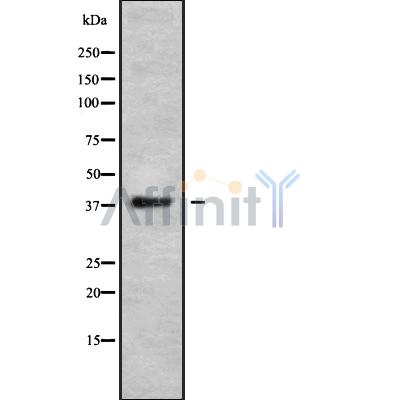APOL6 Antibody - #DF9219
| Product: | APOL6 Antibody |
| Catalog: | DF9219 |
| Description: | Rabbit polyclonal antibody to APOL6 |
| Application: | WB |
| Reactivity: | Human |
| Mol.Wt.: | 38 kDa; 38kD(Calculated). |
| Uniprot: | Q9BWW8 |
| RRID: | AB_2842415 |
Related Downloads
Protocols
Product Info
*The optimal dilutions should be determined by the end user.
*Tips:
WB: For western blot detection of denatured protein samples. IHC: For immunohistochemical detection of paraffin sections (IHC-p) or frozen sections (IHC-f) of tissue samples. IF/ICC: For immunofluorescence detection of cell samples. ELISA(peptide): For ELISA detection of antigenic peptide.
Cite Format: Affinity Biosciences Cat# DF9219, RRID:AB_2842415.
Fold/Unfold
2310076O14Rik; APOL VI; ApoL-VI; APOL6; APOL6_HUMAN; Apolipoprotein L VI; Apolipoprotein L, 6; Apolipoprotein L-VI; Apolipoprotein L6; APOLVI; DKFZp667M075; FLJ38562; FLJ90164; MGC57495;
Immunogens
Widely expressed; highly expressed in the uterus, fetal brain and spinal cord, also detected in heart, liver, lung, colon, spleen, thymus, prostate, placenta, adrenal gland, salivary and mammary gland.
- Q9BWW8 APOL6_HUMAN:
- Protein BLAST With
- NCBI/
- ExPASy/
- Uniprot
MDNQAERESEAGVGLQRDEDDAPLCEDVELQDGDLSPEEKIFLREFPRLKEDLKGNIDKLRALADDIDKTHKKFTKANMVATSTAVISGVMSLLGLALAPATGGGSLLLSTAGQGLATAAGVTSIVSGTLERSKNKEAQARAEDILPTYDQEDREDEEEKADYVTAAGKIIYNLRNTLKYAKKNVRAFWKLRANPRLANATKRLLTTGQVSSRSRVQVQKAFAGTTLAMTKNARVLGGVMSAFSLGYDLATLSKEWKHLKEGARTKFAEELRAKALELERKLTELTQLYKSLQQKVRSRARGVGKDLTGTCETEAYWKELREHVWMWLWLCVCLCVCVYVQFT
PTMs - Q9BWW8 As Substrate
| Site | PTM Type | Enzyme | Source |
|---|---|---|---|
| K40 | Ubiquitination | Uniprot | |
| K59 | Ubiquitination | Uniprot | |
| K160 | Ubiquitination | Uniprot | |
| K169 | Ubiquitination | Uniprot | |
| K190 | Ubiquitination | Uniprot | |
| K202 | Ubiquitination | Uniprot | |
| T206 | Phosphorylation | Uniprot | |
| K220 | Ubiquitination | Uniprot | |
| K231 | Ubiquitination | Uniprot | |
| K266 | Ubiquitination | Uniprot | |
| K274 | Acetylation | Uniprot | |
| K274 | Ubiquitination | Uniprot | |
| K281 | Ubiquitination | Uniprot | |
| K290 | Ubiquitination | Uniprot | |
| K295 | Ubiquitination | Uniprot | |
| K305 | Ubiquitination | Uniprot |
Research Backgrounds
May affect the movement of lipids in the cytoplasm or allow the binding of lipids to organelles.
Cytoplasm.
Widely expressed; highly expressed in the uterus, fetal brain and spinal cord, also detected in heart, liver, lung, colon, spleen, thymus, prostate, placenta, adrenal gland, salivary and mammary gland.
Belongs to the apolipoprotein L family.
References
Application: IF/ICC Species: Human Sample: T24 cells
Restrictive clause
Affinity Biosciences tests all products strictly. Citations are provided as a resource for additional applications that have not been validated by Affinity Biosciences. Please choose the appropriate format for each application and consult Materials and Methods sections for additional details about the use of any product in these publications.
For Research Use Only.
Not for use in diagnostic or therapeutic procedures. Not for resale. Not for distribution without written consent. Affinity Biosciences will not be held responsible for patent infringement or other violations that may occur with the use of our products. Affinity Biosciences, Affinity Biosciences Logo and all other trademarks are the property of Affinity Biosciences LTD.

